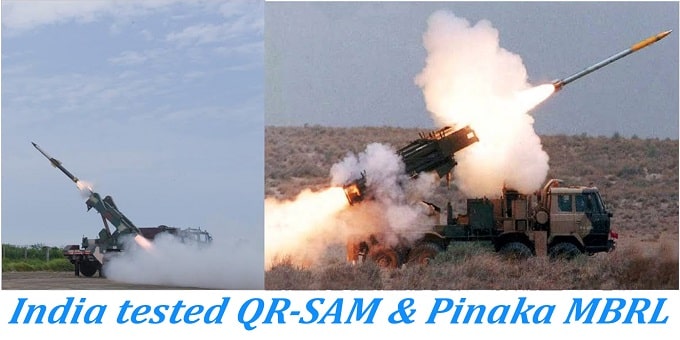On December 20, 2019, Defence Research and Development Organisation (DRDO), the premier Research and development (R&D) organization of the country, has successfully flight tested the upgraded version of the Pinaka rocket Mark-II in salvo mode from DRDO’s Proof and Experimental Establishment firing test range at Chandipur testing center in Odisha. These were tracked by multiple range systems viz. telemetry, radars, Electro-Optical Tracking System (EOTS).
Another one: DRDO also test-fired its all-weather tracked-chassis Quick Reaction Surface-to-Air Missile (QR-SAM) from the launch pad-3 at the Interim Test Range (ITR) at Chandipur in Odisha.
 Key Points:
Key Points:
i. About Pinaka Mark-II:
It is a developed as a missile by combining navigation, control and guidance systems.
Pinaka,an artillery missile system, can hit up to 75 km in enemy territory with full accuracy & and can fire 12 rockets in less than 45 seconds. It is jointly developed by Armament Research and Development Center, Pune, ARCI and Defense Research and Development Laboratory of Hyderabad.
ii. QR-SAM:
Developed by DRDO,It also hit multiple targets within a range of about 25 – 30 km with two vehicle configurations for area air defence.
The special thing of QR-SAM missile is that it aims to defend Army formations operating in plains & semi-desert areas, including those enemy missiles that suddenly appear at close range.
It uses solid-fuel propellant &equipped with electronic countermeasures against jamming by aircraft radars. It was integrated with live warhead with proximity fuse and was tracked by multiple range systems viz. telemetry, radars, Electro-Optical Tracking System (EOTS).
iii.Background:
The Indian Army had used the Pinaka Mark-1 variant during the 1999 Kargil War. The Indian Army had precisely targeted Pakistani posts stationed on the outposts of the mountain. It fires 12 high explosive rockets in just 44 seconds.
While,The 1st trial of the QRSAM was conducted on June 4, 2017.
About DRDO:
Formed– 1958
Headquarters– New Delhi
Motto– Strength’s Origin is in Science
Chairman– Dr G. Satheesh Reddy





